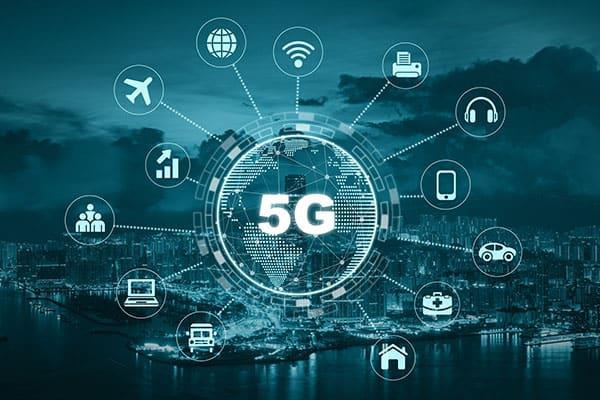5G (Fifth Generation) technology is the latest evolution of mobile network technology, designed to provide faster speeds, lower latency (faster response times), and more reliable connections compared to previous generations like 4G. The technology is expected to significantly impact how we use mobile devices, access the internet, and connect various devices in our increasingly digital world.
Key Features of 5G Technology:
- Faster Speeds:
- 5G offers download speeds that can theoretically reach up to 10 Gbps (10,000 Mbps), which is up to 100 times faster than 4G. This means you can download large files, stream 4K videos, or play online games with virtually no buffering or lag.
- Lower Latency:
- Latency refers to the time it takes for data to travel between two points. With 5G, the latency is expected to be as low as 1 millisecond (ms), compared to 30–50 ms in 4G. This ultra-low latency is crucial for applications like autonomous vehicles, real-time remote control of machines, and immersive virtual reality (VR) or augmented reality (AR) experiences.
- Increased Capacity and Connectivity:
- 5G can handle a much larger number of devices connected at the same time, which is essential as the number of Internet of Things (IoT) devices grows. With 5G, there’s greater capacity for things like smart homes, wearable devices, smart cities, and more.
- Improved Reliability:
- The reliability and stability of 5G networks are enhanced, meaning connections won’t drop or fail as often. This is particularly important in critical sectors like healthcare (telemedicine), transportation (autonomous vehicles), and industry (smart manufacturing).
Applications and Uses of 5G:
- Enhanced Mobile Broadband: With faster speeds and more capacity, 5G enhances mobile data experiences, allowing for seamless 4K and 8K video streaming, high-speed internet browsing, and improved app performance on smartphones and tablets.
- Autonomous Vehicles: 5G enables real-time communication between vehicles, traffic signals, and infrastructure, supporting the development and deployment of autonomous driving technologies.
- Industrial IoT: In industries like manufacturing, agriculture, and logistics, 5G can connect a large number of IoT devices (such as sensors, machinery, and robots) to improve automation, predictive maintenance, and efficiency.
- Smart Cities: 5G can help build smart cities by connecting a wide range of devices and infrastructure, such as traffic lights, public safety cameras, environmental monitoring systems, and smart meters.
- Healthcare: 5G can enable telemedicine services like remote surgeries, high-definition video consultations, and real-time monitoring of patients, particularly in rural or underserved areas.
- Augmented and Virtual Reality (AR/VR): The ultra-low latency and high speeds of 5G are perfect for applications like AR and VR, which require a high data throughput to render graphics in real-time.
- Gaming: Cloud gaming and real-time multiplayer games will benefit from faster, more reliable connections, allowing for an almost console-like experience on mobile devices.
5G Network Architecture:
5G uses a combination of different radio frequencies (from low-band to high-band millimeter waves), which allows it to balance wide coverage with ultra-fast speeds. There are three main types of 5G spectrum:
- Low-band spectrum: Offers good coverage and speed, but not the fastest data speeds.
- Mid-band spectrum: Offers a balance of speed and coverage, with much faster speeds than low-band.
- High-band (millimeter wave) spectrum: Provides extremely high speeds but shorter range and less penetration through physical objects (e.g., walls).
5G Deployment:
5G networks are being rolled out globally by mobile carriers. However, the adoption is gradual due to infrastructure challenges and regulatory hurdles. Full 5G availability will depend on the regions, network providers, and government policies. The next few years will see more widespread rollout as carriers and tech companies build out 5G infrastructure.
Challenges and Considerations:
- Infrastructure Costs: Upgrading to 5G requires significant investment in new infrastructure, such as small cell towers and fiber-optic networks, to support the higher frequency bands.
- Spectrum Allocation: Governments need to allocate sufficient spectrum to 5G providers, which can be a complex process.
- Security Concerns: The increased connectivity and more critical applications of 5G raise concerns about data privacy and cybersecurity, requiring robust security protocols.
- Health Concerns: Some people have expressed concerns about the health effects of electromagnetic radiation from 5G towers, but studies have not proven any significant risks. The technology complies with international safety standards for electromagnetic exposure.
In Summary:
5G is a transformative technology that promises to revolutionize how we live, work, and interact with the world around us. With its high-speed data transmission, low latency, and massive connectivity potential, 5G will support a range of innovative applications from autonomous vehicles to smart cities, telemedicine, and beyond. While its full potential is still being realized, 5G is set to play a critical role in shaping the future of technology.







